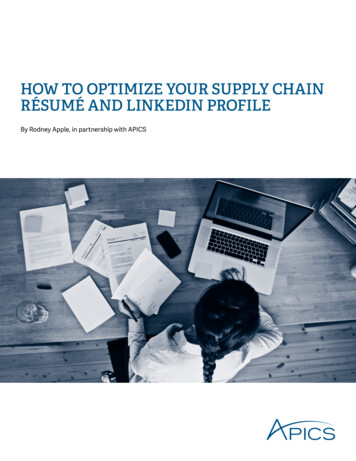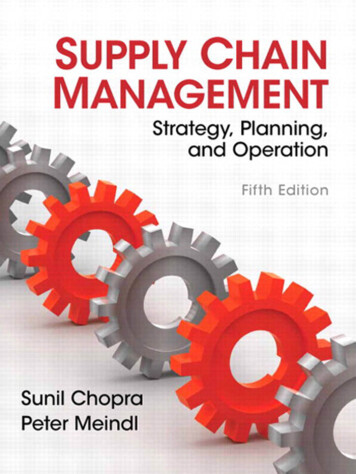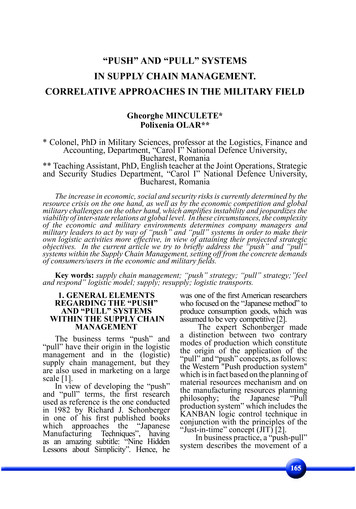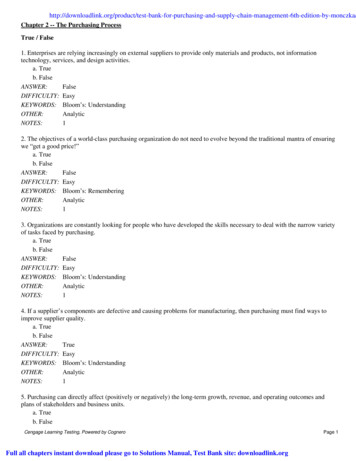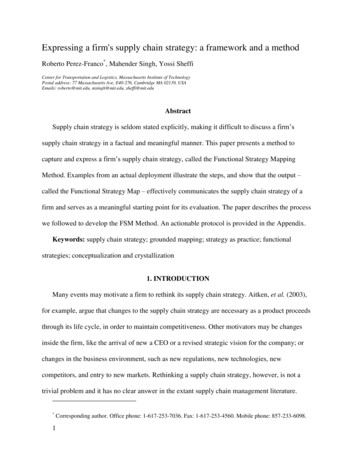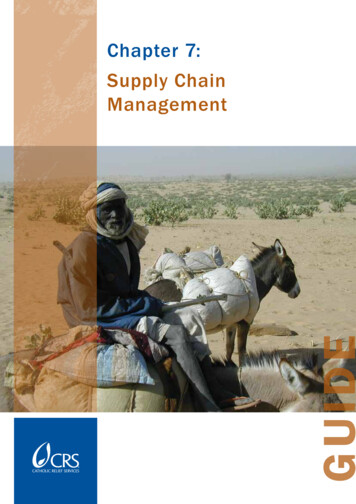
Transcription
Chapter 7:guid eSupply ChainManagement
Cover photo: A man fleeing the border. Catholic Relief Services is respondingto the urgent needs of Sudanese refugees in Chad who have fled escalatingconflict in western Sudan’s Darfur region. Photo by Kevin Hartigan/CRS. 2011 Catholic Relief Services – United States Conference of Catholic Bishops228 West Lexington StreetBaltimore, MD 21201 – USApqsdrequests@crs.orgDownload this and other CRS publications at www.crsprogramquality.org.
TABLE OF CONTENTSProcurement Process Map.2Purpose of This Guide.3What Function Does Procurement Perform?.3Summary of This Guide.3Key Principles.5Procurement Business Process 7.1 – Planning. 10Step 7.1.1 – Demand Planning. 11Step 7.1.2 – Supply Planning. 14Step 7.1.3 – Balancing Supply and Demand. 17Step 7.1.4 – Plan Logistics Network. 20Procurement Business Process 7.2 – Sourcing. 23Step 7.2.1 – Request. 24Step 7.2.2 – Purchase and Acquisition. 27Step 7.2.3 – Contracts. 31Step 7.2.4 – Manage Shipping. 34Step 7.2.5 – Manage Payments. 38Step 7.2.6 – Manage Suppliers. 42Procurement Business Process 7.3 – Fulfillment. 45Step 7.3.1 – Warehouse and Inventory Management. 46Step 7.3.2 – Distribution. 53Step 7.3.3 – Fleet Management. 56Procurement Business Process 7.4 – Reporting. 59Step 7.4.1 – Reporting and Record Keeping. 61Compliance Checklist for Procurement. 64Glossary. 75References. 84i
Appendix A: Sample Inventory Report Form. 85Appendix B: Sample Waybill. 86Appendix C: Sample Goods Received Note. 87Appendix D: Sample Commodity Status Report. 88Appendix E: Sample Recipient Status Report. 89Appendix F: Sample Bed-Net Supply and Distribution Report . 90Appendix G: Sample Procurement Officer Job Description. 91Appendix H: Sample Assistant Procurement Officer Job Description. 93Appendix I: Sample EFR Logistics Officer Job Description. 95ii
Chapter 7:Supply ChainManagementKarl Grobl for CRSMissionaries of Charity’sGandhiji Prem Nivas LeprosyCentre near Kolkata, India,where leprosy patients receivetreatment and learn how to liveand work with their disabilities.Started by Mother Teresa in 1958.11
P r o c u r e m e n t P r o c e ss M a pPROCUREMENT Process MapPlanningSourcingFulfillingProcess 7.1Process 7.2Process 7.3Can you forecast how muchof which goods you will need?see page 10Do you have a system inplace to convert requests intopurchases and orders?see page 23How do you manage the flowand storage of goods?see page 45ReportingProcess 7.4Do you have a reportingsystem that meets the needsand regulations of donors?see page 592
Purpose of This GuideThe guidelines presented herein are a compendium of supply chain management(SCM) business descriptions, requirements, minimum standards, and best practicesintended to aid an organization’s management and staff in the development and/orenhancement of their SCM policies, procedures, and practices.Organizations interested in developing or improving their business processesand related policies and procedural manuals will use the information in thisguide in different ways. Each and every organization has its own uniqueunderstanding, interpretation, and implementation of SCM business processes.What Function DoesProcurement Perform?Every organization needs to procure, store, and distribute goods, materials(products), and services to support its activities. In addition, organizationsmust manage and monitor the products as they move into and out of the storeor warehouse.The components of SCM—procurement, transport, warehousing, and inventorymanagement—are important business processes that allow an organizationto obtain optimal value for resources expended on goods and services. Theeffective management of resources through sound procurement, warehousing,and inventory management processes contribute to the achievement of theoperational and strategic goals of a project and an organization. Efficientand effective SCM processes reflect professionalism, compliance, fairness,reliability, and transparency to the organization’s constituencies (members,donors, recipients, local authorities, and the general public). Therefore, SCMrequires considerable attention.There is no one correct way to establish SCM policies and procedures. Factorssuch as the size of the organization, the availability of vendors to supplynecessary goods and services, and the cash flow and credit of the organizationwill influence the organization’s approach to procurement. The size of theorganization will also impact the formation of SCM policies and procedures.Summary of This GuideThis guide covers the procurement of goods, materials, and services and thestorage and management of inventories. It is sub-divided into four sections:Planning, Sourcing, Fulfillment, and Reporting. Each one of these sections isassociated with specific reporting and record-keeping requirements.3
The pillars of ScmPlanSourceFulfillPlan DemandRequestWarehouse & InventoryOperational PlansGenerate RequestReceiveDemand ForecastingAssess InventoryDispositionValidate Demand ForecastPurchaseRFQPlan SupplyBid AnalysisSupply ForecastingCreate POValidate Supply ForecastStage/StorePick/Kit/PackCycle CountMonitor Stocking LevelManage Inventory AgeReturn/Recondition MaterialAsset ManagementBalance Demand & SupplyManage ShippingSupplier CollaborationSecure Inbound TransportationMatch Demand/SupplyPort Receipt and ClearingIdentify GapsTransport to Primary Wrhs.Resolve VariancesDistributeManage PaymentsRoute/Schedule DeliveryProcess Vendor InvoicesReceipt at DestinationPlan Logistics NetworkNetwork DesignManage SuppliersPlan WarehouseSupplier/Donor ManagementPlan TransportContract ManagementCatalog/Item ManagementReporting &VisibilityReportingEvent ManagementFleet ManagementFleet ManagementMaintenance RecordingTrack & TraceThe first SCM pillar contains sections that focus on core SCM planningprocesses that include demand planning, supply planning, balancing supplyand demand, and logistics planning.The second pillar contains sections that focus on SCM sourcing processesincluding requests, purchases, suppliers management, donation management,shipping management, and payment management.4
The third pillar focuses on fulfillment processes, with sections on warehousing,inventory management, and distributions and asset management.Reporting is used throughout each of the three pillars to facilitate transitionsand enable communication.It is recommended to use the HOCAI assessment tool (see Chapter 2) and thepillar questionnaires (found at the beginning of each section) before readingthe guide in order to select relevant sections for each organization or user.Depending on the needs of the organization, it may not be necessary to readall the sections or chapters.Key Principles1. Key Principles OverviewThe SCM process is guided by principles that provide guidance. When properlyapplied, they lead to best practices in the SCM process. The principles include:a. Competition, Transparency, and OpennessProcurement activities will be conducted in an open and impartial mannerusing transparent, open purchasing processes, adequately testingthe market, avoiding biased specifications, and treating all suppliersconsistently and equitably, so that potential vendors and donors can haveconfidence in the outcome of the procurement process.b. Value for MoneyAgencies must pursue value for money purchasing outcomes (e.g., throughweighing the benefits of the purchase against the cost of the purchase)taking into consideration the following factors:i. The purchase meets specificationsii. Quality assuranceiii. The capacity of the supplier (e.g., their managerial and technical abilities)iv. T he advantages of buying locally, which may include such benefits asbetter delivery times, local backup and servicing, and the availabilityof spare partsc. Compliance With All Legal and Regulatory RequirementsAll procurement will be made in accordance with the legal regulations ofthe jurisdiction and comply with all donor regulations.d. Internal Controls and Risk Management MeasuresTo the extent possible, internal control mechanisms and risk managementmeasures will be put into place to safeguard resources. This is covered ingreater detail below.5
e. Conflict of InterestThe organization and its staff shall at all times avoid situations in whichprivate interests conflict, might reasonably be thought to conflict, or havepotential to conflict with the organization’s mandate. This is covered ingreater detail below.f. TraceabilityEach product that enters the supply chain needs to be individually recordedand remain fully traceable throughout the chain, from planning to postdistribution reporting.g. AccountabilityOrganizations need to ensure that they are accountable for all goods andservices they procure, store, and distribute or use. Regular reporting isnecessary to provide constituencies with a clear picture of the supply chainstatus. All processes and information are subject to audit.2. Key Principles: Detailed Internal Controlsa. Internal Control BasicsEmployees conducting business transactions on behalf of the organizationhold a position of trust that dictates their actions should be governed by thehighest standards of personal and business conduct. The organization doesnot purchase products or services for the personal use of its employees, exceptunder specific programs as approved by the Executive Board. All transactionsmust be undertaken for the exclusive benefit of the organization and its mission.b. SCM Internal Control Minimum Requirements There is an approval authority matrix and all requisitions andpurchase orders are approved as per the matrix. There is segregation of duty between the different functions. Conflict of interest is declared and managed. Gifts, donations, and gratuities are managed in the best interest ofthe organization and purchase ethics. A person does not approve his or her own requisitions orreimbursements.c. Segregation of DutiesThere may not be enough staff members to maintain the full segregation ofduties. The minimum level of segregation of duties is as follows:6
The person whoshould notprepares a purchase requisitionapprove that purchase requisition.sends out a quote request andconducts the bid committee meetingreceive the purchase quote.prepares a purchase orderapprove that purchase order.issues a purchase orderreceive the goods.d. Internal Control MatrixControl AreasControl ObjectivesControl ActivitiesPurchases are transparent.A “Conflict of Interest” clause is implemented. Purchasers and bidcommittee members are required to declare any circumstance inwhich there is a conflict of interest.Transactions are reviewed and approved by an authorized approver,have a valid business purpose, and are appropriate for the accountsto which they are charged (e.g., department, funding source,natural account, or project). An authority chart is put in practice andrequisitions are approved as per authority.PurchaseRequisition &Approval ProcessItems that are being purchasedare intended for agency useonly and not driven by personaluse requirement.Appropriate segregation of duties between the initiator, preparer,and approver are in place.All items procured have been received before payment is authorized,unless an agreement to pre-pay has been arranged.Single invoices are never paid more than once. Final payments forgoods are made only when they have been received in full and thecontrol processes ensure that there is no duplicate payment.A bid committee is established.Payment andLinkage to FinanceRecordsMaintenancePayments are made oncompletion of a procurementprocess as per the agreementwith the vendor.Single invoices are never paid more than once. Payments for goodsare made only when they have been received and the controlprocesses ensure
14.12.2010 · The guidelines presented herein are a compendium of supply chain management (SCM) business descriptions, requirements, minimum standards, and best practices intended to aid an organization’s management and staff in the development and/or enhancement of their SCM policies, procedures, and practices. Organizations interested in developing or improving their business

